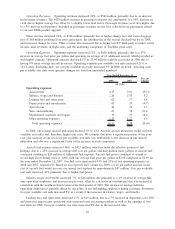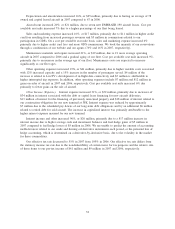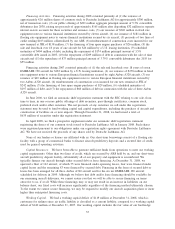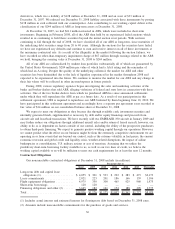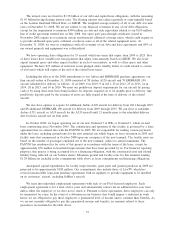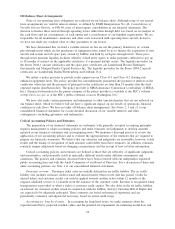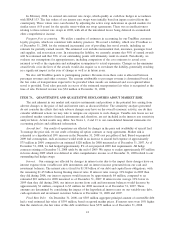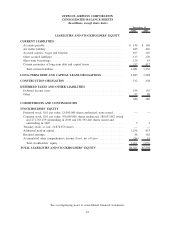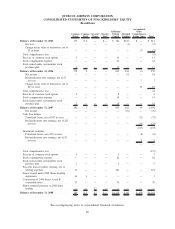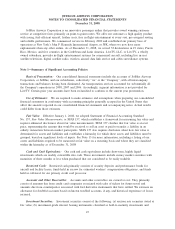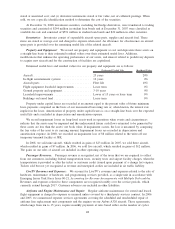JetBlue Airlines 2008 Annual Report Download - page 47
Download and view the complete annual report
Please find page 47 of the 2008 JetBlue Airlines annual report below. You can navigate through the pages in the report by either clicking on the pages listed below, or by using the keyword search tool below to find specific information within the annual report.Off-Balance Sheet Arrangements
None of our operating lease obligations are reflected on our balance sheet. Although some of our aircraft
lease arrangements are variable interest entities, as defined by FASB Interpretation No. 46, Consolidation of
Variable Interest Entities, or FIN 46, none of them require consolidation in our financial statements. The
decision to finance these aircraft through operating leases rather than through debt was based on an analysis of
the cash flows and tax consequences of each option and a consideration of our liquidity requirements. We are
responsible for all maintenance, insurance and other costs associated with operating these aircraft; however,
we have not made any residual value or other guarantees to our lessors.
We have determined that we hold a variable interest in, but are not the primary beneficiary of, certain
pass-through trusts which are the purchasers of equipment notes issued by us to finance the acquisition of new
aircraft and certain aircraft spare parts owned by JetBlue and held by such pass-through trusts. These pass-
through trusts maintain liquidity facilities whereby a third party agrees to make payments sufficient to pay up
to 18 months of interest on the applicable certificates if a payment default occurs. The liquidity providers for
the Series 2004-1 aircraft certificates and the spare parts certificates are Landesbank Hessen-Thu
¨ringen
Girozentrale and Morgan Stanley Capital Services Inc. The liquidity providers for the Series 2004-2 aircraft
certificates are Landesbank Baden-Wu
¨rttemberg and Citibank, N.A.
We utilize a policy provider to provide credit support on our Class G-1 and Class G-2 floating rate
enhanced equipment notes. The policy provider has unconditionally guaranteed the payment of interest on the
certificates when due and the payment of principal on the certificates no later than 18 months after the final
expected regular distribution date. The policy provider is MBIA Insurance Corporation (a subsidiary of MBIA,
Inc.). Financial information for the parent company of the policy provider is available at the SEC’s website
at http://www.sec.gov or at the SEC’s public reference room in Washington, D.C.
We have also made certain guarantees and indemnities to other unrelated parties that are not reflected on
our balance sheet, which we believe will not have a significant impact on our results of operations, financial
condition or cash flows. We have no other off-balance sheet arrangements. See Notes 2, 3 and 12 to our
consolidated financial statements for a more detailed discussion of our variable interests and other
contingencies, including guarantees and indemnities.
Critical Accounting Policies and Estimates
The preparation of our financial statements in conformity with generally accepted accounting principles
requires management to adopt accounting policies and make estimates and judgments to develop amounts
reported in our financial statements and accompanying notes. We maintain a thorough process to review the
application of our accounting policies and to evaluate the appropriateness of the estimates that are required to
prepare our financials statements. We believe that our estimates and judgments are reasonable; however, actual
results and the timing of recognition of such amounts could differ from those estimates. In addition, estimates
routinely require adjustment based on changing circumstances and the receipt of new or better information.
Critical accounting policies and estimates are defined as those that are reflective of significant judgments
and uncertainties, and potentially result in materially different results under different assumptions and
conditions. The policies and estimates discussed below have been reviewed with our independent registered
public accounting firm and with the Audit Committee of our Board of Directors. For a discussion of these and
other accounting policies, see Note 1 to our consolidated financial statements.
Passenger revenue. Passenger ticket sales are initially deferred in air traffic liability. The air traffic
liability also includes customer credits issued and unused tickets whose travel date has passed. Credit for
unused tickets and customer credits can each be applied towards another ticket within 12 months of the
original scheduled service or 12 months from the issuance of the customer credit. Revenue is recognized when
transportation is provided or when a ticket or customer credit expires. We also defer in the air traffic liability,
an estimate for customer credits issued in conjunction with the JetBlue Airways Customer Bill of Rights that
are expected to be ultimately redeemed. These estimates are based on historical experience and are
periodically evaluated, and adjusted if necessary, based on actual credit usage.
Accounting for long-lived assets. In accounting for long-lived assets, we make estimates about the
expected useful lives, projected residual values and the potential for impairment. In estimating useful lives and
38



